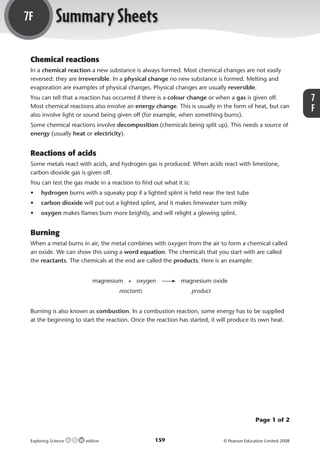More Related Content
Similar to Chemical reactions
Similar to Chemical reactions (20)
More from themassmaker (20)
Chemical reactions
- 1. 7F Summary Sheets
Chemical reactions
In a chemical reaction a new substance is always formed. Most chemical changes are not easily
reversed: they are irreversible. In a physical change no new substance is formed. Melting and
evaporation are examples of physical changes. Physical changes are usually reversible.
You can tell that a reaction has occurred if there is a colour change or when a gas is given off. 7
Most chemical reactions also involve an energy change. This is usually in the form of heat, but can
also involve light or sound being given off (for example, when something burns).
F
Some chemical reactions involve decomposition (chemicals being split up). This needs a source of
energy (usually heat or electricity).
Reactions of acids
Some metals react with acids, and hydrogen gas is produced. When acids react with limestone,
carbon dioxide gas is given off.
You can test the gas made in a reaction to find out what it is:
• hydrogen burns with a squeaky pop if a lighted splint is held near the test tube
• carbon dioxide will put out a lighted splint, and it makes limewater turn milky
• oxygen makes flames burn more brightly, and will relight a glowing splint.
Burning
When a metal burns in air, the metal combines with oxygen from the air to form a chemical called
an oxide. We can show this using a word equation. The chemicals that you start with are called
the reactants. The chemicals at the end are called the products. Here is an example:
magnesium + oxygen magnesium oxide
reactants product
Burning is also known as combustion. In a combustion reaction, some energy has to be supplied
at the beginning to start the reaction. Once the reaction has started, it will produce its own heat.
Page 1 of 2
Exploring Science edition 159 © Pearson Education Limited 2008
M06_ES_AB_Y7_2445_U7F.indd 159 4/3/08 12:37:02
- 2. 7F Summary Sheets (continued)
A fire needs three things to keep burning: fuel, oxygen and heat. We show these three things on
the fire triangle.
7
F
EN
HE
YG
AT
OX
FUEL
If any one of these three things is taken away, the fire will go out.
Fire extinguishers are used for putting out fires. There are different types of fire extinguisher, and
it is important always to use the correct sort for a particular fire. Sand or fire blankets can also be
used to put out fires.
Water is often used to put out fires, because it takes away the heat. However, water should never
be used on oil or petrol fires, because it makes the burning fuel spread out. Fire blankets and foam,
powder or carbon dioxide (CO2) extinguishers work by stopping oxygen getting to the flames.
Fossil fuels contain a lot of carbon and hydrogen. When they burn, they use up oxygen from the
air and produce water and carbon dioxide. We can show the reaction using a word equation.
Energy is not in this equation because it is not a chemical substance.
fuel + oxygen carbon dioxide + water
Pollution can occur if there is not enough oxygen for complete combustion. Carbon monoxide is
a poisonous gas, and soot (carbon) can also be formed if the oxygen supply is restricted further.
Smoke is made up of soot and any other solid particles, such as metal oxides.
Explosions
Explosions are very fast reactions that give out a lot of heat and produce lots of gases. Fuels such
as natural gas can produce an explosive mixture with oxygen. This is a combustion explosion.
Explosives are chemicals that often contain all the oxygen they need to react inside the chemical.
They can react by decomposition as they do not need any oxygen from the air.
Some explosives, such as nitroglycerine, are very unstable and will react with only a tiny amount
of added energy. A safer explosive, such as dynamite, will not react until a detonator is used.
Explosives are used for weapons, quarrying rock, building roads and demolishing old buildings.
Page 2 of 2
Exploring Science edition 160 © Pearson Education Limited 2008
M06_ES_AB_Y7_2445_U7F.indd 160 4/3/08 12:37:03
